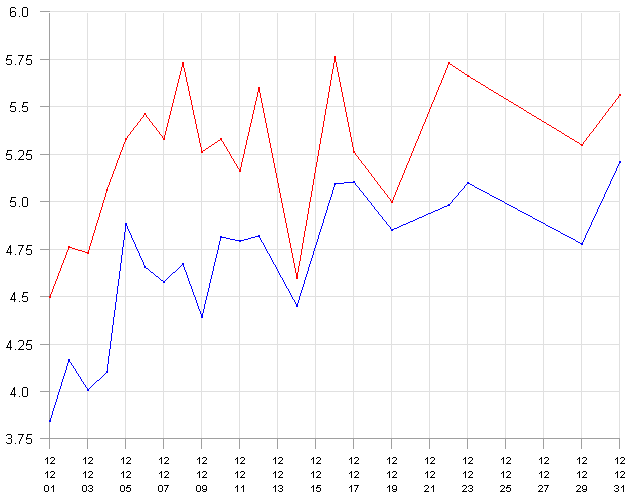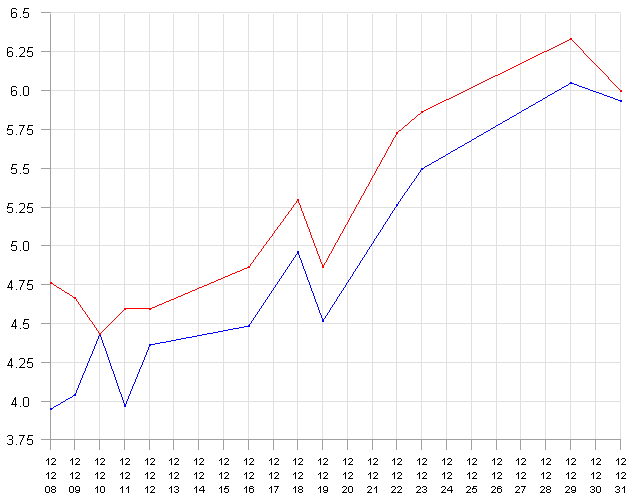Dual N-Back is a game developed to enhance cognitive abilities, more specifically the working memory. Since my interests include a wide range of activities (such as mathematics, nutrition science, music theory, juggling, …), I always seek new ways to make my learning methods and my workflow more effective, and dual N-Back has proven itself to be very helpful in this respect.
What is dual N-Back
While playing dual N-Back, you will see a variation on the following screen, depending on the program you use (I use Brain Workshop):

During every step of the game, a square appears at one of the eight positions you can see above (the middle position isn’t used), and, at the same time, you will hear a sound (people usually use recordings of someone saying letters of the English alphabet; I use a recording of a piano playing the tones of the C-major scale because I want a purely auditory input). Your task is to remember the sequence and press the corresponding key (A for position, L for audio) whenever the position or the sound is the same as N steps ago. For example if you played dual 2-Back and if the sounds were the following:
you would press the ‘sound’ key for every letter that is underlined because the same letter appeared exactly two steps before. On the other hand, if you were playing dual 3-Back, you would press the key for the following underlined letters:
The task is even harder in that you have to remember two independent sequences—the positions and the sounds. When you start playing dual N-Back, even dual 2-Back may seem incredibly hard for a few days. However, your brain will continually adapt to the task, and after a while it becomes really easy. For that reason, most computer programs will increase the N depending on how well you do.
What is dual N-Back good for?
The great thing about the concept of dual N-Back is that it forces your brain to increase the capacity of your working memory (or at least to use it better). Working memory is a form of memory which your brain uses in a manner analogous to a computer using RAM—it stores information that can be quickly read and manipulated by your thinking processes. This is extremely important for problem solving and creative activities.
For example, if you try to solve a mathematical problem, you have to see the web of implications between various statements in the theory in order to find a path from what you already know to the conclusion you would like to make. The greater the capacity of your working memory is, the greater is your chance to find such a path (you can imagine it as trying to find a way through a maze while seeing only a small neighbourhood around you; the larger the neighbourhood is, the easier it will be to find the correct way).
You may ask what is the difference between just learning to remember sequences of letters, numbers, sounds, or something like that and the concept of N-Back. The main advantage of N-Back is that it prevents remembering information in ‘chunks’. For example, if I tell you the sentence “it is an amazing method”, it probably poses no problem for you to remember it and repeat it. From one point of view, you have just remembered a string consisting of 19 characters, and yet, if I ask you to remember “dnwugpsjvnlrkjsascq”, you will be most probably unable to do so.
And that is exactly what happens when you train your memory by remembering sequences of symbols or sounds; your brain starts to use the so called “chunking”. You train yourself to remember the information in larger “chunks” which are represented just as one ‘symbol’ (such as a word) in your mind. The problem is that you do not really increase your memory capacity in doing so; you just increase your chunking abilities.
Another problem is that people tend to translate one form of input into another. For example, I have noticed that I am able to remember much shorter sequences of numbers when I try to remember just the symbols than when I subvocalize the names of the numbers. Dual N-Back tries to avoid this effect by using a combination of visual and auditory stimuli.
My Dual N-Back progress
I had already had some experience with dual N-Back about half a year ago (and I got somewhere in between of 3-Back and 4-Back). The nice thing is that it seems that once you reach a certain level, you stay at it even if you do not practice for a longer time.
The following graphs show my progress during December. The red curve shows the highest level I have reached during that day, the blue curve the average level. It is, however, important to understand how the level is computed; to reach a level means to be able to get at least 50% right. If I get 80% right, the N-Back level is increased and the try already counts as N+1. For other percentages, the score is linearly interpolated. Also, as you can see, I was somewhat lazy during the holidays. My training also wasn’t very intense; often I did as little as two sessions per day.

I also did the combination Position + Image N-Back where instead of sound an image instead of the blue square is displayed. As images, I use the numbers from 0 to 9.

From my subjective point of view, I must say that dual N-Back really works (i.e. the results translate also to other activities distinct from the task itself). For example, I played a game in which one has to press arrows in exactly the same order as they appear on the screen. Before December, I was only able to do a sequence of 8 arrows correctly, but now I can do 10, without actually playing the game during December. In another game, one has to find and remember a way through a maze whose walls then disappear, and one has to find his way through the maze just from what he remembers. If you hit an (invisible) wall, you die. After the first month of playing dual N-Back, I’ve noticed that the size of the maze I am able to navigate in increased significantly (again without actually playing the game during the time).
 Tip: Are you a non-native English speaker? I have just finished creating a
Tip: Are you a non-native English speaker? I have just finished creating a  Web App
Web App
